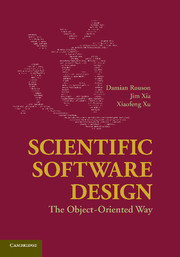Book contents
- Frontmatter
- Contents
- List of Figures
- List of Tables
- Preface
- Acknowledgments
- Disclaimer
- PART I THE TAO OF SCIENTIFIC OOP
- 1 Development Costs and Complexity
- 2 The Object-Oriented Way
- 3 Scientific OOP
- PART II SOOP TO NUTS AND BOLTS
- PART III GUMBO SOOP
- Appendix A Mathematical Background
- Appendix B Unified Modeling Language Elements
- Bibliography
- Index
2 - The Object-Oriented Way
from PART I - THE TAO OF SCIENTIFIC OOP
Published online by Cambridge University Press: 01 June 2011
- Frontmatter
- Contents
- List of Figures
- List of Tables
- Preface
- Acknowledgments
- Disclaimer
- PART I THE TAO OF SCIENTIFIC OOP
- 1 Development Costs and Complexity
- 2 The Object-Oriented Way
- 3 Scientific OOP
- PART II SOOP TO NUTS AND BOLTS
- PART III GUMBO SOOP
- Appendix A Mathematical Background
- Appendix B Unified Modeling Language Elements
- Bibliography
- Index
Summary
“Believe those who are seeking the truth. Doubt those who find it.”
Andre GideNomenclature
Chapter 1 introduced the main pillars of object-orientation: encapsulation, information hiding, polymorphism, and inheritance. The current chapter provides more detailed definitions and demonstrations of these concepts in Fortran 2003 along with a complexity analysis. As noted in the preface, we primarily target three audiences: Fortran 95 programmers unfamiliar with OOP, Fortran 95 programmers who emulate OOP, and C++ programmers familiar with OOP. In reading this chapter, the first audience will learn the basic OOP concepts in a familiar syntax. The second audience will find that many of the emulation techniques that have been suggested in the literature can be converted quite easily to employ the intrinsic OOP constructs of Fortran 2003. The third audience will benefit from the exposure to OOP in a language other than their native tongue. All will hopefully benefit from the complexity analysis at the end of the chapter.
We hope that using the newest features of Fortran gives this book lasting value. Operating at the bleeding edge, however, presents some short-term limitations. As of January 2011, only two compilers implemented the full Fortran 2003 standard:
The IBM XL Fortran compiler,
The Cray Compiler Environment.
However, it appears that the Numerical Algorithms Group (NAG), Gnu Fortran (gfortran), and Intel compilers are advancing rapidly enough that they are likely to have the features required to compile the code in this book by the time of publication (Chivers and Sleightholme 2010).
Information
- Type
- Chapter
- Information
- Scientific Software DesignThe Object-Oriented Way, pp. 31 - 56Publisher: Cambridge University PressPrint publication year: 2011
